19.1.5: Diversity and Evolutionary Relationships of the Plants
- Page ID
- 5949
Evolution and Classification
The organisms we call plants are assigned to a single clade; that is, a natural grouping based on the belief that they have all evolved from a common ancestor more recent than any shared with other organisms. Among the criteria for doing this are:
- their shared use of the photosynthetic pigments chlorophyll a and chlorophyll b
- the similarities in the nucleotide sequences of the genes encoding both their small subunit (18S) and large subunit (25S) ribosomal RNA
- their shared cellulose cell wall
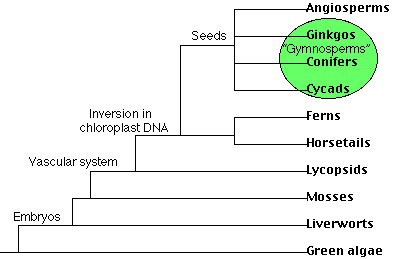
We shall examine here a selection of the most prominent groups.
Green Algae
The ancestors of these organisms were the most primitive members of the clade. In other words, organisms that we would put in this division were probably the ancestors of all the other plants. There are some 7000 species living today. They include:
- microscopic, unicellular forms like Chlamydomonas
- colonial forms like the filamentous Spirogyra
- multicellular forms like Volvox and Ulva, the sea lettuce
Although some of the multicellular forms are large, they never develop more than a few types of differentiated cells and their fertilized eggs do not develop into an embryo.
Green algae are an important source of food for many aquatic animals. When lakes and ponds are "fertilized" with phosphates and nitrates (e.g., from sewage and the runoff from fertilized fields and lawns), green algae often form extensive algal "blooms".
Liverworts and Mosses (Bryophytes)
These are fairly simple plants that do produce a number of differentiated cell types and whose fertilized egg develops into a distinct embryo.
However, they have neither vascular tissue (xylem and phloem) nor woody tissue and thus never grow very large. Some 16,000 living species are known. Most grow in moist places.
Lycopsids (Lycophytes)
Prominent members of this group are often called club mosses. They are not mosses at all, but vascular plants with xylem and phloem running through their roots, stems, and leaves. The leaves are quite simple and small with their vascular tissue in a single, unbranched vein. The "club" of their name comes from the appearance of their spore-forming structures called strobili. Club mosses are also sometimes called "ground pines", but they are not pines either. The photo shows Lycopodium obscurum.
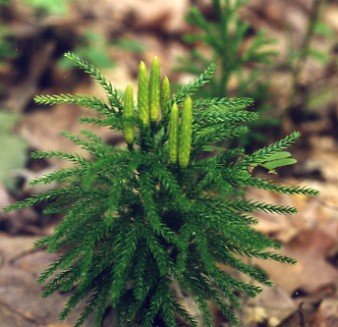
About 1000 species of lycopsids exist today. All are small (those in the photo stand about 8 in. [20 cm] tall), but it was not always so. Fossil lycopsids in the Mississippian and Pennsylvanian periods (the so-called Carboniferous era) reached heights of 100 feet (30 meters). Their remains contributed to the formation of coal.
Chloroplast Genes
Chloroplasts (as well as mitochondria) have their own genome. The diagram (based on the work of Ohyama, K. et al., Nature 322:572, 1986 and Linda A. Raubeson and R. K. Jansen, Science 225:1697, 1992) shows the genome of the first chloroplast DNA to be sequenced, that of the liverwort Marchantia polymorpha. It contains 121,024 base pairs encoding 128 genes. The short lines indicate a few of the tRNA genes, some of which are labeled.
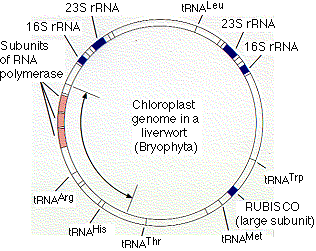
The order of the genes between the arrows (~6:30 to ~10:00) is also found in the lycopsids. But in all other vascular plants, this region is inverted and the order of the genes is precisely reversed. This provides further evidence that the other vascular plants we shall examine below, the
- horsetails
- ferns
- gymnosperms
- angiosperms
belong to a separate clade.
Horsetails
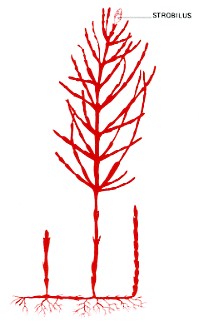
(Classified as Equisetopsida although many botanists prefer the older term Sphenopsida.)
The common name comes from the characteristic pattern of branching: whorls or rings of branchlets arising from an above-ground shoot. The shoot develops each season from an underground stem (rhizome). Horsetails often grow in sandy places and incorporate silica in their stems. This gives them an abrasive quality which caused them to once be used for cleaning pots and pans, which gave rise to another common name: scouring rush.
Only one genus, Equisetum, containing about 25 species, survives today. However, many other, much larger, species were dominant features of the Carboniferous and, like the early lycopsids, contributed to the formation of coal.
The drawing is of Equisetum palustre, a common horsetail. Spores are formed in the strobilus.
Ferns
(Assigned to the Pteridopsida although some botanisits prefer Filicopsida.)
Some 15,000 species of ferns live on earth today. Many of these are found in the tropics where some — the "tree ferns" — may grow to heights of 40 ft (13 m) or more. The ferns of temperate regions are smaller. They are usually found in damp, shady locations. Their stems — called rhizomes — as well as their roots grow underground and are perennial. Their leaves, called fronds, grow up from the rhizome each spring.
Seed Plants (Spermatophytes)
Gymnosperms
Fossil from the Devonian period reveal fernlike plants that were heterosporous; that is, produced two kinds of spores: microspores (male) and megaspores (female). The megaspores were not released from the parent sporophyte. Fertilization took place within the tissue of the parent sporophyte thus freed from dependence on surface water. However, the necessity for the microspores to be carried from one plant to another in order to reach the female gametophyte robbed them of their value as agents of dispersal. This function was taken over by seeds - dormant, protected, embryo sporophytes.
The seed ferns, as these plants are called, were among the earliest gymnosperms. Although seed ferns are now extinct, some of their living descendants, the cycads, resemble them closely. Cycads reveal their ancient lineage by the fact that after the microspore reaches the ovule, it liberates a ciliated sperm which, swimming in moisture supplied by the parent sporophyte, reaches the egg. Ginkgos are also gymnosperms that use motile sperm.
Conifers
These gymnosperms get their name from their cones: male cones in which the in which microspores develop and female cones in which megaspores develop. The microspores develop into pollen grains that are carried by the wind to the female cones. Here each germinates into a pollen tube which grows into the tissues of the female cone until it reaches the vicinity of the egg. (In pines, this may take a year.) Then the tube ruptures and a sperm nucleus fuses with the egg to form the zygote.
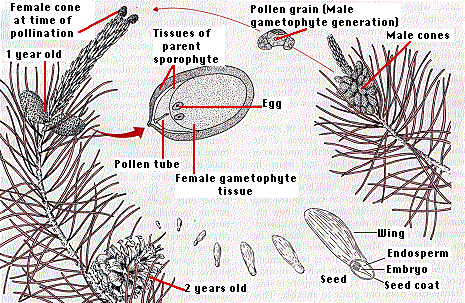
After fertilization, the zygote develops into a tiny embryo sporophyte plant. There are approximately 630 species of living conifers. They include the pines, spruces and firs. Conifers include the largest and the oldest of all living organisms. One redwood (genus Sequoia) growing in California is almost 400 feet (122 meters) high. Bristlecone pines growing in the mountains of eastern California are more than 4000 years old.
Although most conifers are evergreen, their leaves are modified as "needles", and these reduce snow load and transpiration during the winter in the harsh high-latitude climates where conifers are the dominant species of plants. But by retaining their needles during the winter, conifers are ready to begin photosynthesis immediately upon the return of spring.
Coniferous forests are of great economic importance producing lumber for building and pulp for paper making.
Angiosperms
Although angiosperms appear in the fossil record in Jurassic deposits, it was not until the end of the Mesozoic era that angiosperms became the dominant plants of the landscape. That they dominate the earth's flora today is clear: there are some 260,000 species of living angiosperms; the rest of the plant kingdom includes only some 47,700 species. Currently, the angiosperms are classified in some 54 orders (The names of the orders end in ..ales, e.g., Arabidopsis is in the order Brassicales.). Each order contains from one to several dozen families (Family names end in ..aceae, e.g., Arabidopsis is in the family Brassicaceae).
Monocots and Dicots
Of over 400 families of angiosperms, some 80 of them fall into a single clade, called monocots because their seeds have only a single cotyledon. The remainder are the dicots whose seeds have two cotyledons. The large majority of these occupy a single clade called the eudicots.
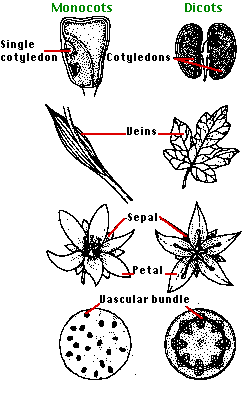
Monocot traits:
- a single cotyledon in their seed
- parallel venation in their leaves
- petals and sepals in 3s or some multiple thereof
- vascular bundles scattered randomly throughout the stem
Monocots include:
- palms (Arecaceae)
- orchids (Orchidaceae)
- yams, sweet potatoes (Dioscoreaceae)
- lilies, onion, asparagus (Liliaceae)
- bananas (Musaceae)
- and all the grasses (Poaceae), which include many of our most important plants such as
- corn (maize)
- wheat
- rice
- and all the other cereal grains upon which we depend so heavily for food as well as
- sugar cane and bamboo
Dicot traits:
- two cotyledons in their seeds
- netted venation in their leaves
- petals and sepals in 4s, 5s, or some multiple thereof
- vascular bundles in the stem arranged in a radial pattern like spokes of a wheel.
Here is a selection of eudicots.
| Family | Examples |
|---|---|
| Anacardiaceae | poison ivy, cashews, pistachios |
| Asteraceae | asters and all the other composite flowers |
| Brassicaceae | cabbage, turnip; Arabidopsis, and other mustards |
| Cactaceae | cacti |
| Cucurbitaceae | squashes |
| Euphorbiaceae | cassava (manioc) |
| Fabaceae | beans and all the other legumes |
| Fagaceae | oaks |
| Linaceae | flax (source of linen) |
| Malvaceae | cotton |
| Oleaceae | olives, ashes, lilacs |
| Rosaceae | roses, apples, peaches, strawberries, almonds |
| Rubiaceae | coffee |
| Rutaceae | oranges and other citrus fruits |
| Solanaceae | potato, tomato, tobacco |
| Theaceae | tea |
| Vitaceae | grapes |
Contributors and Attributions
John W. Kimball. This content is distributed under a Creative Commons Attribution 3.0 Unported (CC BY 3.0) license and made possible by funding from The Saylor Foundation.


